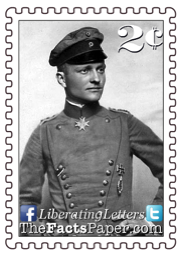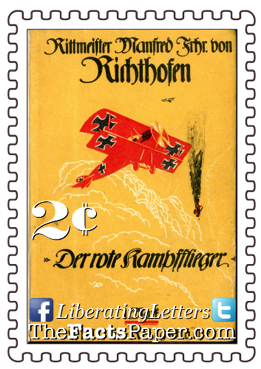On April 20, 1918, Richthofen achieved his 80th and last confirmed aerial victory, the most for both sides in World War I. The following day he engaged in the dogfight with Canadian fighters May and Brown. While Brown was credited with the kill shot, further evidence indicates Richthofen’s fatal chest shot was fired by the Australians on the ground. The angle and trajectory of the bullet is consistent with a shot from below while Brown was above him.
Regardless, Allied fighters made sure to treat the skilled enemy pilot with the respect and dignity due the leading ace pilot. Surrounded by flowers, his body lay in state for a day in a nearby hanger as hundreds of British soldiers passed by to pay their respects. Richthofen received a funeral with full military honors on April 22, and was laid to rest in a cemetery near Amiens, France, just a little over a week before he would have turned 26. The British took photos and then dropped them over the flying ace’s base with the message:
TO THE GERMAN FLYING CORPS:
Rittmeister Baron Manfred von Richthofen was killed in aerial combat on April 21st, 1918.
He was buried with full military honours.
From the British Royal Air Force
Following the war, Richthofen’s body was moved to the Prussian national military cemetery in Berlin. However, the Invalidenfriedhof Cemetery fell inside the Russian sector when the Berlin Wall was constructed in 1961. (see America's Pale Blue Trabant) Therefore, the family requested permission to move him to the family plot in Wiesbaden, which the East German government allowed in 1975.
Over the years, the Red Baron has been memorialized in many fashions, from a Peanuts cartoon, to a song by The Royal Guard inspired by Snoopy and the Christmas Truce of 1914, to Red Baron frozen pizzas. (see If Only For A Moment) War should never be glorified, Liberty, as it always results in senseless deaths. However, through such times humans often find inner strength and endurance they never knew they had. Leading American World War I ace Eddie Rickenbacker obtained his first kill just a week after Richthofen died and lived to become an amazing military and business leader. (see A Hero’s Hero) The week after that, your great-grandfather R held off German infantrymen by himself throughout the night as his unit died around him. (see A Hero’s Story) He later told family members he witnessed the Red Baron get shot down. While it’s possible he saw another red plane, his position at the time places him very near the dogfight making it highly probable it was Richthofen’s plane he saw.
Last week’s letter discussed the civility among the soldiers during the South’s surrender in the Civil War. (see Civility War Ends) Similarly, despite the ruthless behavior Richthofen often displayed in his kills, the British soldiers honored him and gave him a proper burial. Liberty, it is a fact you will have disagreements with others throughout your life. Some may even get pretty heated with others, possibly ending a long-time friendship. However, it is important to remember that your opponents are God’s children too and should be regarded as such. You don’t need to abandon your principles or beliefs, yet you can treat them with respect. In doing so, it says much more about you than about those who oppose you.
That’s my 2 cents.
Love,
Mom
Shortly after his return to the front in mid-June, several Jastas, short for Jagdstaffel, were combined to form Jagdgeschwader 1, also known as “The Flying Circus.” Richthofen was given the honor of commanding the unit. Back in the air, Richthofen felt truly at home again, but tragedy struck within weeks.
“Suddenly there was a blow to my head! I was hit! For a moment I was completely paralized [sic] . . . My hands dropped to the side, my legs dangled inside the fuselage. The worst part was that the blow on the head had affected my optic nerve and I was completely blinded. The machine dived down.”
Within approximately a half mile above the ground, Richthofen regained enough of his vision to safely land the plane. However, the fractured skull he received from the bullet wound on July 6 grounded him until mid-August. It also plagued him with severe and frequent headaches.
April 21, 2018
Dear Liberty,
Second Lieutenant Wilfred May rounded his plane in his first combat flight. Even though his longtime friend and superior, Captain Arthur Ray Brown, told him just to observe, May engaged. While initially doing well, his guns soon jammed. Therefore, he broke from the dogfight and headed for base. However, Captain Manfred von Richthofen noticed the single plane exit the pack. He also broke away with his eyes set on his next kill.
Richthofen had grown up as an avid hunter. He perfected his skills in catching prized game. Now, a 25-year-old fighter pilot, he used those same skills and attention in catching enemy fighters. Today was no exception, or at least he thought.
Soon after Richthofen fell in behind May, Brown noticed his friend in trouble. He too broke from the dogfight and started after the German fighter chasing May. The trio quickly entered Allied territory where May descended to the treetops to shake his predator. As they raced over France’s Morlancourt Ridge, Richthofen attempted to cut May off. However, as they crested the ridge, Australian ground troops nestled below took action. Upon seeing the bright red plane, machine gunners opened fire as Brown shot at him from behind.
May escaped as the German Fokker triplane began wobbling towards the earth. All watched as the bright red plane landed. Soldiers raced to the site to hear the infamous, but respected, Red Baron utter “kaputt” before taking his last breath. Soldiers quickly began taking bits and pieces from the plane as souvenirs. As Richthofen always did the same with his kills, their actions were an interesting irony, and commonplace at the time.
Manfred Albrecht Freiherr von Richthofen entered the world on May 2, 1892, in Kleinburg, Kingdom of Prussia or present-day Wroclaw, Poland. As his parents were Prussian aristocrats, Manfred inherited the blood of nobility along with the title of Freiherr, literally meaning “Free Lord,” but often translated as “baron”.
An incredibly athletic boy, Richthofen won numerous awards as a gymnast yet he also excelled at horseback riding and hunting. At age 11, he began military training and joined an Uhlan cavalry unit upon completing his cadet training in 1911. He saw action on both the Eastern and Western fronts, earning the Iron Cross for his courage under fire. However, his days on top of the horse were not meant to last.
While the cavalry had a long and legendary history, 20th century technology introduced two new forms of combat during World War I, trench warfare and air combat. (see The Forgotten General, A Tale Of Two Soldiers, and A Hero’s Hero) One put the soldier in the ground while the other put him in the air, and neither had a place for horses. Therefore, cavalry units were disbanded, placing the men in alternative positions usually away from combat. Upon being assigned to a supply branch, Richthofen requested a transfer to the imperial German Air Service. In a letter to his commanding officer, he supposedly stated, “My dear Excellency, I have not gone to war to collect cheese and eggs, but for another purpose.” His request was granted in May of 1915.
His first few months, Richthofen flew as an observer, detailing missions and drawing maps. Upon meeting his hero, German ace fighter pilot Oswald Boelcke, Richthofen’s purpose came into focus. In October of 1915, he began training as a pilot, earning his pilot’s certificate on December 25. Two months later, he convinced his brother, Lothar, a military trainer, to join him in the air.
In August of 1916, Boelcke was on a quest to recruit pilots for his new group “Jagdstaffel 2” or “hunting squadron”. While visiting his brother, Wilhelm, who was also Richthofen’s commander, Boelcke approached Richthofen with an offer to join the team of beginner pilots. Richthofen jumped at the opportunity to train with Boelcke in Lagnicourt, France.
Boelcke shaped and molded the young pilots, leading them to numerous victories. To distinguish his unit, Boelcke painted the nose of his plane red so all would know him. Richthofen learned quickly under Boelcke’s wing, earning his first confirmed aerial victory on September 17, 1916. Just as quickly, he earned the title “flying ace” following four more victories.
An honored and well-decorated pilot, Boelcke’s career ended when he was shot down on October 28. Germany looked for a new flying ace hero to fill his role, and Richthofen wanted to be that pilot. Only achieving his first kill a month before, Richthofen was determined to become a better hunter in the air than he was on the ground.
Richthofen quickly obtained the 16 victories needed to receive Germany’s highest award for bravery, the Pour le Mérite, on January 12, 1917. As a result, he received his own unit, Jagdstaffel 11, two days later becoming Germany’s new hero. As commander, he recruited several talented pilots, including Lothar, his younger brother. Following his former commander, Richthofen made his own mark on the world.
“One day, for no particular reason, I got the idea to paint my crate glaring red. After that, absolutely everyone knew my red bird. In fact, even my opponents were not completely unaware.”
It did not take long before the Central Powers and Allies alike both feared and admired the man in the red plane. Playing off his title of nobility, he earned such nicknames as the Bloody Baron, the Jolly Red Baron, and the American favorite, the Red Baron. However, other names consisted of the Red Devil, the Red Falcon, the Red Knight of Germany, Le Petit Rouge, and Diable Rouge. Yet to the Germans, he was Der röte Kampfflieger ("The Red Battle Flier").
Over the next few months, his reputation grew as he accumulated fifty-two downed Allied planes by April, breaking Boelcke’s record of forty. Despite his amazing flying skills, his mercilessness in shooting defenseless pilots escaping their downed aircraft as well as those abandoning their planes mid-air resulted in the Allies resolve to stop him, which the Germans knew.
Not wanting to lose another flying hero so soon, German authorities ordered Richthofen home for some rest and relaxation. Leaving his unit in the capable hands of his brother on May 1, Richthofen left to meet Kaiser Wilhelm II before embarking on a propaganda tour. For two weeks, he visited and spoke to school children, generals and countrymen, gathering support for the war effort before heading home. To keep the war publicity going, Richthofen was asked to pen his memoirs, likely with the help of a propagandist ghostwriter. Entitled Der röte Kampfflieger, Richthofen’s autobiography gave valuable insight into the mind of the brilliant, yet often cold-hearted, flying ace. However, before his death, Richthofen denounced the book, stating it was too pompous and he was “no longer that kind of person.”
THE RED KNIGHT
OF GERMANY




